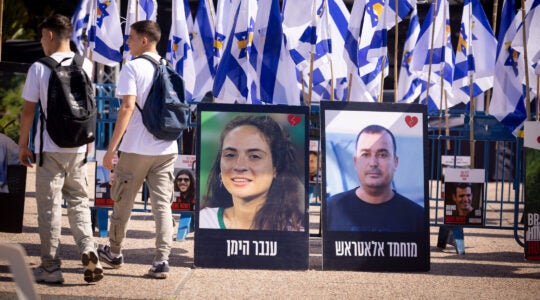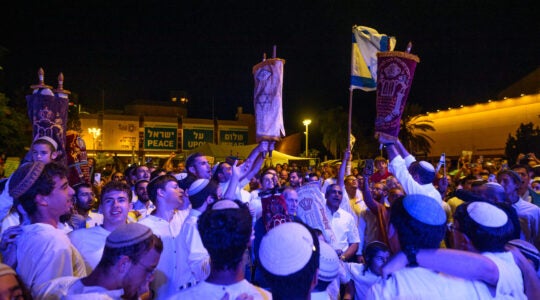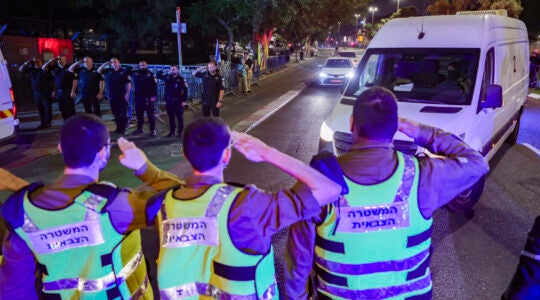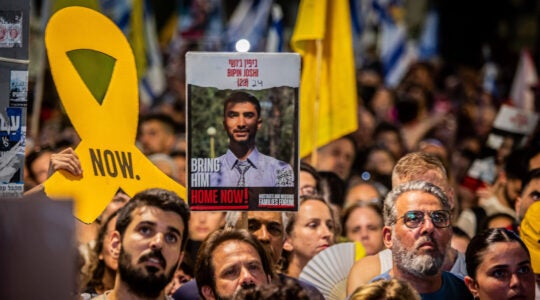The “Seeking Kin” column aims to help reunite long-lost friends and relatives.
BALTIMORE (JTA) – The springtime wind that blew an envelope right to Nurith Tzabari Daube in 2008 carried her on a four-year expedition that’s breathed new life into a long-dead soldier and shone a light upon some caring schoolchildren.
The Raanana retiree had joined 50 others on a daylong bus tour of northern Israel that included a stop at Kibbutz Kinneret’s cemetery, just across the road from the Sea of Galilee’s southern shore. There, the group visited the graves of legendary pre-state poet Rachel Bluwstein and beloved contemporary songwriter Naomi Shemer.
A muddied white envelope danced around the ground a bit before landing at Daube’s feet. She picked it up, and a message on the front seized her attention: “To the relatives of Yisrael Suta, zichrono l’vracha” (may his memory be for a blessing). The handwritten Hebrew note on lined paper that Daube discovered within was dated 2 Iyar 5768 (May 7, 2008), Israel’s Memorial Day. It read:
“Hello. We, the sixth-grade students of the Naomi Shemer Kinneret School, regularly encounter the stories of soldiers killed in and around the Sea of Galilee. We are sad about the death of Yisrael, and we join in your sorrow. We venerate all soldiers whose loss provided us security in the Land of Israel. Signed, the sixth-grade kids of Kinneret.”
Wanting to deliver the item to its intended recipients, Daube soon contacted the Israel Defense Forces’ Memorialization Department. The unit, she figured, could speedily connect her to the soldier’s family. Daube heard nothing for a year, so she wrote again. Still, no response.
Daube then approached the school’s principal. Iris Moran wrote back, explaining that every Memorial Day the pupils at her regional school – located on the kibbutz’s grounds – honor the 30 soldiers buried there. A memorial site on the kibbutz tells about each soldier, and Moran sent Daube all the information available on the man in question. His name was Yisrael Schwartzman; Suta was his nickname.
Armed with Moran’s materials, Daube again contacted the IDF, and the third time was the charm. The IDF confirmed her information and sent her to the Schwartzman page on its Web site. There, she devoured even more nuggets about the fallen soldier and saw his picture.
What Daube learned left her impressed by Schwartzman’s goodness, empathy and citizenship – qualities the school pupils had unwittingly emulated.
She learned that Schwartzman was born in Tel Aviv on Dec. 19, 1929, attended the city’s Balfour Elementary School and then the Herzliya Gymnasium (high school) and was a Boy Scout. Schwartzman was an exceptional student: a boy who skipped first grade, multiplied complex numbers in his head and reportedly could recite each generational step – both forward and backward – linking Adam and Jesus.
In spring 1947, at age 17, Schwartzman joined a youth group affiliated with the pre-state Palmach fighting force. Following their graduation that summer, he and some buddies ventured to the Negev to help lay the national water carrier. Then they swung north to work at Kibbutz Sarid in the Jezreel Valley. By autumn, they were hawking flowers in Tel Aviv to benefit two poor families.
Now serving in the Palmach’s Yiftach Brigade, Schwartzman combined pre-military training and agricultural settlement in a Gadnah program at Kibbutz Dafna in the Galilee panhandle. As the British Mandate ended and Israel’s War of Independence began in spring 1948, Schwartzman fought with Yiftach’s Third Battalion in the pivotal battles for Safed and Nebi Yusha. On May 16, he wrote to his parents, Pinchas and Puah, from a room in Metullah, adjacent to the northeastern border with Lebanon. It was the only letter in which Schwartzman revealed he’d seen combat.
“You certainly can understand that there’s no chance we’ll see each other soon. They’re not granting leave now, except in rare cases,” he wrote. “There are others who haven’t been back home in half a year or more. There’s no reason I’d get leave ahead of them.”
The letter reached his parents on May 22 – three days after the writer was killed by Syrian forces occupying the Tzemach police station. Pvt. Yisrael Schwartzman, precisely 18 years and five months old, was laid to rest just a bit west of there.
Knowing that Pinchas and Puah must be long dead, Daube wondered how to fulfill her mission to deliver the pupils’ letter to Schwartzman’s next of kin. The IDF knew of only one relative – Chana Giladi, his sister – but had not maintained contact with her. A previous letter Schwartzman wrote mentioned Chaim Ben-Dor, a friend from the unit. Ben-Dor fell in battle just a few days before Schwartzman. Maybe Ben-Dor’s relatives would remember Schwartzman.
Two months ago – four years into her search and nearly 64 years to the day since Schwartzman’s death – Daube was interviewed by host Izi Mann of Israel’s “Hamador L’chipus Krovim” (Searching for Relatives Bureau) radio program. Just 15 minutes after the broadcast, a listener called Daube to provide names, addresses and telephone numbers for Schwartzman’s brother-in-law and niece. Others sent Mann period articles and mourning notices about Schwartzman.
Schwartzman’s brother-in-law, Yisrael Giladi, told Daube that the young soldier had been an Israeli youth chess champion and that shortly after his death, his bereaved parents changed their surname to Avisar: father of Yisrael.
On July 9, Daube returned to the radio show, this time for a telephone introduction to Schwartzman’s niece. Born a few months after her uncle died, Yael Amit grew up with the Schwartzman legend. “I was thrilled to hear of Nurith’s efforts, and I want to thank her,” Amit said on the show.
Amit met Daube and gave her a copy of a biographical booklet Pinchas and Puah published in their son’s memory. The Kinneret pupils’ simple letter, placed tenderly on Yisrael Schwartzman’s grave one Memorial Day to soften the pain of relatives who didn’t appear, found the addressees at long last. The Sea of Galilee winds had cast it into the hands of a woman from Raanana with three daughters and 13 grandchildren, who redirected it to the sought-for kin.
Schwartzman “did so much for other people. We see the good heart, the values, of this boy. It’s something exceptional. I feel an inexplicable connection to him,” Daube told “Seeking Kin.”
“I know so much about him, and this [experience] gives me the sense of knowing him so many years, of being close to a person who was unique. The story of Schwartzman is the story of pre-state Israel. Serving in the Gadnah, the Palmach, working on kibbutzim – that’s what people did.”
Of the story’s climax, Daube said, “I feel like I served the purpose of transmitting the letter, as the kids intended. It closes the circle, reaching the appropriate hands. The right thing was done.”
The story continues. Daube recently read an email from someone whose parents served with Schwartzman on Kibbutz Dafna and were thrilled to hear of him once again.
“I spoke with the parents. It was very nice,” Daube said. “How a story rolls on – all because of one person.”
If you would like “Seeking Kin” to write about your search for long-lost relatives and friends, please include the principal facts and your contact information in a brief email to Hillel Kuttler at seekingkin@jta.org. “Seeking Kin” is sponsored by Bryna Shuchat and Joshua Landes and family in loving memory of their mother and grandmother, Miriam Shuchat, a lifelong uniter of the Jewish people.
JTA has documented Jewish history in real-time for over a century. Keep our journalism strong by joining us in supporting independent, award-winning reporting.





